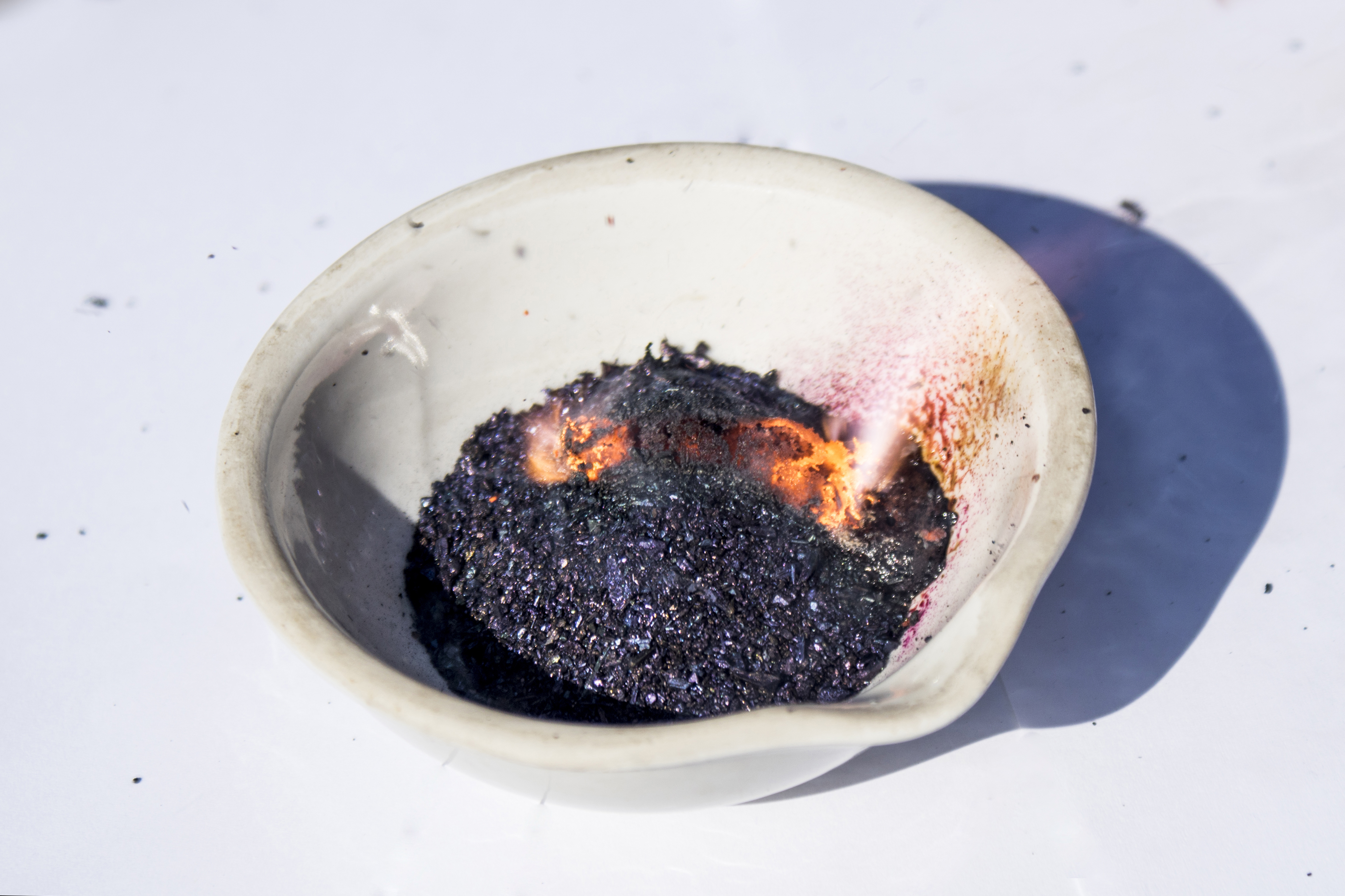Chemical Volcano on:
[Wikipedia]
[Google]
[Amazon]
 The chemical
The chemical
File:Chemical volcano.ogg
File:Glycerol_and_permanganate.webm
File:Glycerol_and_permanganate_2.webm
 The chemical
The chemical redox
Redox (reduction–oxidation, , ) is a type of chemical reaction in which the oxidation states of substrate (chemistry), substrate change. Oxidation is the loss of Electron, electrons or an increase in the oxidation state, while reduction ...
reaction between potassium permanganate and glycerol is often used to demonstrate the powerful oxidizing property of potassium permanganate
A permanganate () is a chemical compound containing the manganate(VII) ion, , the conjugate base of permanganic acid. Because the manganese atom is in the +7 oxidation state, the permanganate(VII) ion is a strong oxidizing agent. The ion is a tra ...
, especially in the presence of organic compounds such as glycerol. The exothermic (heat producing) reaction between potassium permanganate (KMnO4), a strong oxidizing agent
An oxidizing agent (also known as an oxidant, oxidizer, electron recipient, or electron acceptor) is a substance in a redox chemical reaction that gains or "Electron acceptor, accepts"/"receives" an electron from a (called the , , or ). In ot ...
, and glycerol
Glycerol (), also called glycerine in British English and glycerin in American English, is a simple triol compound. It is a colorless, odorless, viscous liquid that is sweet-tasting and non-toxic. The glycerol backbone is found in lipids known ...
(C3H5(OH)3), a readily oxidised organic substance, is an example of an experiment sometimes referred to as a "chemical volcano".
Explanation
Potassium permanganate (KMnO4) is a darkviolet
Violet may refer to:
Common meanings
* Violet (color), a spectral color with wavelengths shorter than blue
* One of a list of plants known as violet, particularly:
** ''Viola'' (plant), a genus of flowering plants
Places United States
* Viol ...
colored powder. Its reaction with glycerol
Glycerol (), also called glycerine in British English and glycerin in American English, is a simple triol compound. It is a colorless, odorless, viscous liquid that is sweet-tasting and non-toxic. The glycerol backbone is found in lipids known ...
(commonly known as glycerin or glycerine) (C3H5(OH)3) is highly exothermic
In thermodynamics, an exothermic process () is a thermodynamic process or reaction that releases energy from the system to its surroundings, usually in the form of heat, but also in a form of light (e.g. a spark, flame, or flash), electricity (e ...
, resulting rapidly in a flame, along with the formation of carbon dioxide
Carbon dioxide (chemical formula ) is a chemical compound made up of molecules that each have one carbon atom covalently double bonded to two oxygen atoms. It is found in the gas state at room temperature. In the air, carbon dioxide is transpar ...
and water vapor
(99.9839 °C)
, -
, Boiling point
,
, -
, specific gas constant
, 461.5 J/( kg·K)
, -
, Heat of vaporization
, 2.27 MJ/kg
, -
, Heat capacity
, 1.864 kJ/(kg·K)
Water vapor, water vapour or aqueous vapor is the gaseous pha ...
:
14KMnO4(s) + 4C3H5(OH)3(l) → 7K2CO3(s) + 7Mn2O3(s) + 5CO2(g) + 16H2O(g).
Crystalline potassium permanganate (KMnO4) is placed in an evaporating dish
An evaporating dish is a piece of laboratory glassware used for the evaporation of solutions and Precipitation (chemistry), supernatant liquids, and sometimes to their melting point. Evaporating dishes are used to evaporate excess solvents – mo ...
. A depression is made at the center of the permanganate powder and glycerol
Glycerol (), also called glycerine in British English and glycerin in American English, is a simple triol compound. It is a colorless, odorless, viscous liquid that is sweet-tasting and non-toxic. The glycerol backbone is found in lipids known ...
liquid is added to it. The white smoke-like vapor produced by the reaction is a mixture of carbon dioxide
Carbon dioxide (chemical formula ) is a chemical compound made up of molecules that each have one carbon atom covalently double bonded to two oxygen atoms. It is found in the gas state at room temperature. In the air, carbon dioxide is transpar ...
gas and water vapor. Since the reaction is highly exothermic, initial sparking occurs, followed by a lilac
''Syringa'' is a genus of 12 currently recognized species of flowering plant, flowering woody plants in the olive family or Oleaceae called lilacs. These lilacs are native to woodland and scrub from southeastern Europe to eastern Asia, and wid ...
- or pink
Pink is the color of a namesake flower that is a pale tint of red. It was first used as a color name in the late 17th century. According to surveys in Europe and the United States, pink is the color most often associated with charm, politeness, ...
-colored flame. When energy or heat is added to electron
The electron ( or ) is a subatomic particle with a negative one elementary electric charge. Electrons belong to the first generation of the lepton particle family,
and are generally thought to be elementary particles because they have no kn ...
s, their energy level increases to an excited state
In quantum mechanics, an excited state of a system (such as an atom, molecule or nucleus) is any quantum state of the system that has a higher energy than the ground state (that is, more energy than the absolute minimum). Excitation refers to a ...
. This state is short-lived, and once the electrons release the energy, they return to their normal energy levels. During this process the energy is visibly observed as light. When the reaction is complete, it leaves behind a grayish solid with green regions.
Gallery
See also
*Carbon snake
Carbon snake is a demonstration of the dehydration reaction of sugar by concentrated sulfuric acid. With concentrated sulfuric acid, granulated table sugar ( sucrose) performs a degradation reaction which changes its form to a black solid-liqu ...
* Sugar snake
References
{{Reflist Chemistry classroom experiments Articles containing video clips